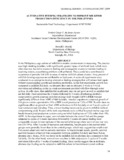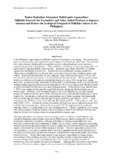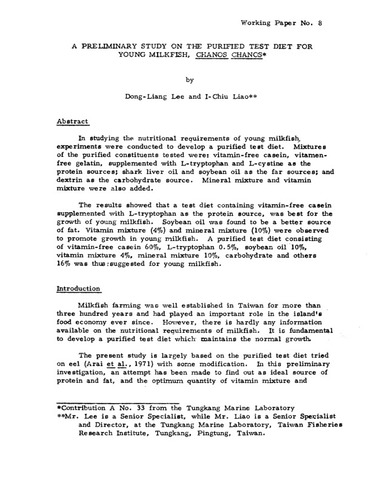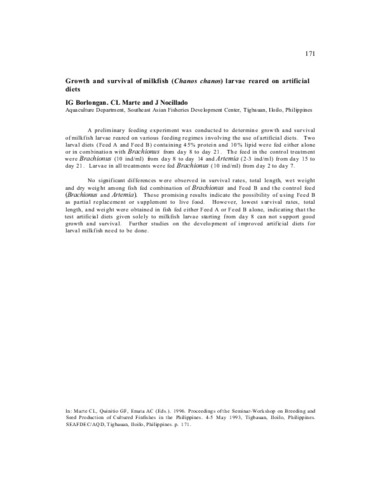Alternative feeding strategies to improve milkfish production efficiency in the Philippines
Share
Abstract
In the Philippines, cage culture of milkfish in marine environments is increasing. The practice uses high stocking densities, with significantly greater inputs of artificial feeds which more often than not, has led to excessive feeding and consequently excessive nutrient loading in receiving waters, exacerbating problems with pollution. These could have contributed to occurrence of periodic fish kills in areas of marine milkfish culture clusters. Sixty percent of milkfish farming expenses are attributable to feed costs. A series of experiments were conducted in an attempt to develop alternative feeding strategies that will reduce feed inputs without compromising growth and resulting production. In the first experiment, growth was compared in milkfish fed daily, on alternate days and on alternate 2-week or 4-week starvation and refeeding cycles in a tank environment provided with flow-through water system. Results show, that milkfish fed on alternate days do not grow as well as milkfish that are fed daily. Feed restriction for 2 weeks followed by 2 weeks of refeeding elicited a compensatory growth response such that average body weight (ABW) of fish was not significantly different from ABW of fish fed daily. Another experiment compared growth of fish given a ration equivalent to 10% of BW (usual practice) or 7.5% of BW. Results show no significant effect on growth or final ABW or biomass in fish fed daily or on 2-week cycles of feed restriction and refeeding. Thus, a lower feeding ration can be given to milkfish without compromising yield. Results of the tank experiments were verified in actual marine cage and brackishwater pond production systems using an initial feeding rate of 7.5% rather than 10% ABW. In the experiment in cages, survival rates between the control fish and the groups subjected to cycles of 2-week starvation followed by 2 weeks of normal feeding were comparable, except for one replicate of the starved-refed group where survival rate was very low (38.78%). After 3 cycles of starvation and refeeding, weight gain in the starved-refed groups were generally lower than in the control groups, which may suggest that small-sized fish cannot adapt very well to periodic starvation. In brackishwater ponds, growth, survival and total biomass at harvest was comparable between milkfish fed daily and those fed on alternate days. Hence, FCR was lower in the milkfish fed on alternate days compared to fish fed daily. On the other hand, survival was very low in fish subjected to 2 cycles of 2 weeks starvation followed by 4 weeks of normal feeding. These results suggest that as in tilapia, alternate day feeding can be adopted to milkfish culture in brackishwater ponds without compromising production while at the same time lowering production cost and environmental impact. Overall, these studies provide two practical strategies, reduced ration size and alternate day feeding, to improve production efficiency of milkfish, the largest finfish aquaculture industry in the Philippines.
Suggested Citation
de Jesus-Ayson, E. G. T., & Borski, R. J. (2010). Alternative feeding strategies to improve milkfish production efficiency in the Philippines. In Technical Reports: Investigations 2007-2009 (Vol. 1, pp. 79–96). Corvallis, Oregon, USA: AquaFish Collaborative Research Support Program, Oregon State University.
Subject
feeding experiments  ; feeding
; feeding  ; milkfish culture
; milkfish culture  ; aquaculture
; aquaculture  ; biomass
; biomass  ; growth
; growth  ; body weight
; body weight  ; milkfish
; milkfish  ; Philippines
; Philippines 
 ; feeding
; feeding  ; milkfish culture
; milkfish culture  ; aquaculture
; aquaculture  ; biomass
; biomass  ; growth
; growth  ; body weight
; body weight  ; milkfish
; milkfish  ; Philippines
; Philippines 
Collections
Related items
Showing items related by title, author, creator and subject.
-
Ration reduction, integrated multitrophic aquaculture (milkfish-seaweed-sea cucumber) and value-added products to improve incomes and reduce the ecological footprint of milkfish culture in the Philippines
de Jesus-Ayson, Evelyn Grace T.; Borski, Russel J. (AquaFish Collaborative Research Support Program, Oregon State University, 2012)In the Philippines, cage culture of milkfish in marine environments is increasing. The practice uses high stocking densities, with significantly greater inputs of artificial feeds which more often than not, have led to ... -
A preliminary study on the purified test diet for young milkfish, Chanos chanos
Lee, Dong-Liang; Liao, I-Chiu (Aquaculture Department, Southeast Asian Fisheries Development Center, 1976)In studying the nutritional requirements of young milkfish experiments were conducted to develop a purified test diet. Mixtures of the purified constituents tested were: vitamin-free casein, vitamin-free gelatin, supplemented ... -
Growth and survival of milkfish (Chanos chanos) larvae reared on artificial diets
Borlongan, I. G.; Marte, C. L.; Nocillado, J. (Aquaculture Department, Southeast Asian Fisheries Development Center, 1996)A preliminary feeding experiment was conducted to determine growth and survival of milkfish larvae reared on various feeding regimes involving the use of artificial diets. Two larval diets (Feed A and Feed B) containing ...




